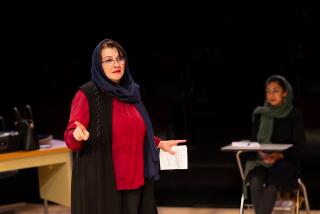‘Goat’ offers a view of humanity’s darker side
- Share via
In his column last Monday [“He’s Seen ‘Sylvia’ and He’s Stumped,” March 28], Al Martinez brandishes his “ignorance” proudly in defense of his “inability to fathom” Edward Albee’s play “The Goat, or Who Is Sylvia?,” which recently played at the Mark Taper Forum. He uses this as a rallying cry to all who fail to understand the play, assuring them they are not alone and reassuring those who missed the production that it was a waste of time.
Martinez then spins a quaint yarn of his own about goats and other animals he’s known, but not loved, in order “to be washed clean” of Albee’s play.
In the current political climate of anti-intellectualism, such posturing against the “cognoscenti,” and reducing such a brilliant playwright and play to a mere obsession with barnyard antics, is not only frightening but unworthy of The Times’ Calendar section, a forum for the arts and culture.
You don’t need a PhD in drama or Greek mythology to find Albee’s play moving and disturbing. You need only be human and have felt even once the desire to transgress into areas considered forbidden.
Not even that -- one need simply possess the imagination to acknowledge that the minds of humans, even the minds of highly intelligent, well-educated and enlightened humans, can wander into dangerous waters.
Albee knows this well, and while the goat may be a metaphor (which is not a dirty word), Albee recognizes the whirlwind consequences of such transgressions.
We can look to history for examples, the most obvious in Nazi Germany, of a society that became murderous despite having produced great poets, composers and philosophers who had attained a high level of civilization.
To not recognize that the potential for transgression lives in all of us and that we usually hold the beast at bay, but sometimes do not, is to open the door to a denial of human possibility and to close the door to art that illuminates the human condition in all its permutations.
More to Read
The biggest entertainment stories
Get our big stories about Hollywood, film, television, music, arts, culture and more right in your inbox as soon as they publish.
You may occasionally receive promotional content from the Los Angeles Times.










